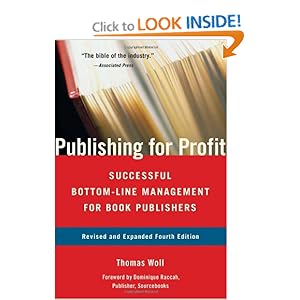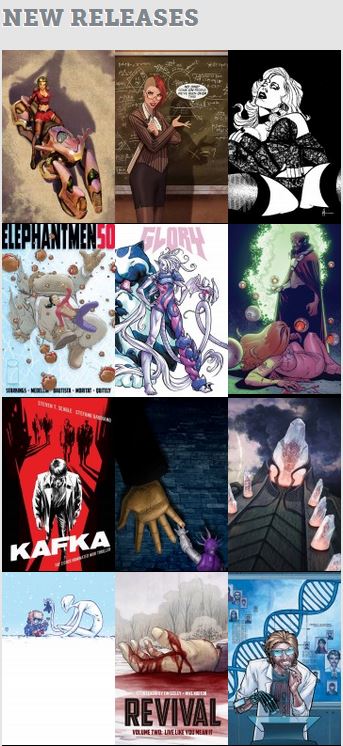Why Aren’t I Selling More Comics?
Ideas within a firm organizational structure, capitalized adequately, properly planned, and transformed into product, can survive and flourish. – Thomas Woll
 I highlighted the above quote from Publishing for Profit: Successful Bottom Line Management for Book Publishers, a resource I’ve been slowly working my way through. Though focused primarily on non-fiction book publishing, there are certainly a lot of lessons that apply to selling comics. I believe that the sentence above is a pretty solid summation of what it takes to sell a successful book and that it also elucidates why many of us in independent comics aren’t selling nearly as many comics as we’d like. Let’s unpack it:
I highlighted the above quote from Publishing for Profit: Successful Bottom Line Management for Book Publishers, a resource I’ve been slowly working my way through. Though focused primarily on non-fiction book publishing, there are certainly a lot of lessons that apply to selling comics. I believe that the sentence above is a pretty solid summation of what it takes to sell a successful book and that it also elucidates why many of us in independent comics aren’t selling nearly as many comics as we’d like. Let’s unpack it:
[Good] ideas
I’m adding the subjective word good to the sentence because in comics, its especially needed. There are a lot of bad ideas out there. What makes an idea bad? Steve Forbes had a great run down of the problem with most bad story ideas, calling them either too derivative of something else, too personal and only make sense to you, too out there and trippy, or they’re too run of the mill. Those really are the biggest culprits. Unoriginal, obscure, and/or boring ideas, are generally bad ideas, and tough to sell.
Luckily, good ideas are in no short supply. Grab a Previews catalog, any month will do. Now, skip past the 60-79 year old properties (aka Big Two) and go to the independent comics section. Every month you’ll find brand new comic titles solicited, and a ton of them (dare I say most) are powered by good ideas. Now, sometimes uncovering that good idea is a difficult process and often you’ll have to work your way through ten tons of awful to get there. But the fact that every single month good new ideas show up on the comic racks must mean there are plenty still out there. Surely there are a few for you and I to come up with, right?
So, while a good idea is crucial to having a comic that will sell, and that some of our comics aren’t selling because the core idea behind them stink, I don’t think bad ideas is the problem most of us who actually produce comics have. Let’s move on to see what is.
Within a Firm Organizational Structure
Show of hands, how many of you have a written business plan for your publishing efforts? No? What about a written budget? What’s that? Yes, I know why make a budget when you have no money. I hear you, brother.
From what I’ve seen, and I’m also looking in the mirror on this one, most independent comics business plan is:
Step 1: Make a Comic.
Step 2: Try to Sell It.
 Because the vast majority of independently financed comic projects fail to even make it through Step 1 due to collaborations falling apart for one of a million reasons, just getting a book in hand often feels like the end of the journey. And sure, if your goal is to create for creation’s sake it CAN be a very rewarding end of the journey. But if you’re trying to build a sustainable business, you need something more.
Because the vast majority of independently financed comic projects fail to even make it through Step 1 due to collaborations falling apart for one of a million reasons, just getting a book in hand often feels like the end of the journey. And sure, if your goal is to create for creation’s sake it CAN be a very rewarding end of the journey. But if you’re trying to build a sustainable business, you need something more.
For a moment, let’s look at Image Comics, as a good example of a comics publishing operation with an solid organizational structure in place. Image has nothing to do with Step 1 above. You’re on your own to make your comic the financing and production is entirely in your bucket as a creator with Image. Where they come in is Step 2 selling your book. And they’ve been getting damn good at that.
Getting an Image deal means creators can be confident that their book will get scheduled and placed into a proven publishing pipeline that sells books, alongside titles from some of the top talent in comics. It means books will be announced far in advance, solicited with full-page ads in Previews (sometimes even the Previews cover), and advance PDFs will be released to hundreds of reviewers. Image books are cross-promoted in other Image titles, on their website, and in interviews, and so on. Image will contact some of the whale retailers about getting specialized variant covers to boost order numbers significantly. What Image does is not rocket science, but it IS a firm organizational structure and one that can be reproduced again and again to sell comics. After all, the numbers don’t lie. Here’s the sales numbers for the last five Image #1s released:
Lazarus #1 – 48,030
Ten Grand #1 – 57,216
Bounce #1 – 24,259
Chin Music #1 – 22,383
Dream Merchant #1 – 14,024
No, my advice is not simply to go get your book published by Image. (Actually, the competition for an Image deal is likely fiercer than ever today, specifically because of their success.) My advice is to think like Image or other publishers. Develop a structure to take your comic from conception all the way through the end of its shelf life. Granted, Image and other pubs didn’t figure everything out all at once, and publishing plans and techniques do evolve over time. So, plans need to be flexible. But if you’re not selling as many books as you would like, maybe it’s a structural problem. Or maybe it’s because you failed to
Capitalized Adequately
Comic creators are lucky. Compared to virtually any other popular entertainment medium – movies, television, music, etc – the cost of producing a professional caliber comic book is relatively cheap. Pencils, paper, ink, computer, scanner, and some software, and you’re pretty much in business.
That said, cheap is a relative term. The fact that you could transform your idea into a comic series for .1% of what it would cost to do it as a major motion picture doesn’t mean much when you don’t have two nickels to rub together.
Unfortunately, most comic ideas are not capitalized adequately, either on the front end/production side of things, or upon release. Is it any wonder, then, that our sales are not where we’d like them to be?
What does adequately look like when it comes to investing in your book? Well, I can tell you what it doesn’t look like. It’s not attaching the cheapest collaborators you can find, or the ones willing to work for nothing, instead of the creators best suited for the story. It’s not releasing your book without any marketing support whatsoever.
I get it. I have to make my budget work just like everyone else, and I’m as keen to save money and cut costs wherever possible. But again, by and large you get out what you put in. And expecting great sales with little capital investment in any publishing endeavor is usually a pipe dream.
properly planned
Most people love TV. Most people love movies.
Most people don’t love comics. It’s a sad fact, but it’s true. Why is this?
Honestly, that’s a huge topic, and a good one for another day. Clearly, Joe Mulvey’s What Do You Really Know About Comics? column sheds some light on the issue. Joe’s interviews show us that a big part of the reason is that most people have a poor conceptions of what kind of stories comics can tell, and all they need to learn to love comics is to actually read some great ones.
But let me offer this part of the reason more people don’t love comics is that by and large, comics are an unreliable medium.
People know how to get their TV shows. There used to be a schedule printed in the newspaper and a guide in every Sunday paper. Now, with DVRs, On-Demand, and Hulu Plus, it’s even easier than ever to get the shows we want to watch.
People also know how to get their movies. They know what’s coming out in the future, because they see teasers and trailers, sometimes years in advance. Release dates get set many months in advance, and a coordinated marketing campaign leads up to the release. And if they miss them or pass on them in the theatre, there’s always RedBox or Netflix a few months later.
But Comics? Comics??? A sizeable number of people are surprised to hear that comic books still even exist, let alone hundreds of new ones come out every Wednesday. But, for those of us who do know how to get our comics, we know how unreliable that process can be.
 Hell, I started collecting comics in the nineties when there was no internet, and the average Image book was four-six months late. (Pretty sure I asked my LCS owner if PITT #2 was out yet on every visit for an entire year.) Indie comics and being late go together like PB & J. Projects are announced, and ship dates missed or in many cases, the project just goes away.
Hell, I started collecting comics in the nineties when there was no internet, and the average Image book was four-six months late. (Pretty sure I asked my LCS owner if PITT #2 was out yet on every visit for an entire year.) Indie comics and being late go together like PB & J. Projects are announced, and ship dates missed or in many cases, the project just goes away.
Again, this is not the pot calling the kettle black I’m just as guilty of late books and vanishing titles as the next creator. But I’m acknowledging that this has an impact on our potential fanbase. At a con a while back, I heard two diehard comic fans who had just done a marathon back-issue diving session, carrying away a loaded pile of books, comment on my table as they walked by. Nope, I’m done with indie comics at cons, one of the fans said. Been burned too many times picking up #1s, and then never hearing from that series or creator again.
But don’t think I’m just wagging the finger at indies. The Big Two are culpable here as well. Even though, by and large, their books ship on time look at what they ship! And more importantly look at who is creating what they ship. The constant shuffling of the decks of creative teams, new directions, reboots, replacement artists, ret-cons it’s hardly an inviting scenario for prospective fans. I mean, imagine if every four episodes of Breaking Bad, they swapped out Bryan Cranston for Howie Mandel? What if you showed up for a Tarantino movie, and instead you got a Spike Lee joint?
Point being, nearly all of these issues could be solved with proper planning. Failure at this is leaving money and interest in comics on the table across the board.
and transformed into product
At the end of the day, it’s all about the product. And in a lot of ways, this is good news for us independents. It has never been cheaper, or easier, to create products on par with the quality of the major publishers even for us little guys.
What the success of so many comics Kickstarter campaigns, the recent sales growth in the direct market, and the ever growing attendance at comic conventions shows is that there is a real hunger for quality comics and graphic novels. This is a fan base that we all have the potential to tap into if we commit to doing just that – creating quality books and products.
can [not just] survive, and [but] flourish.
Okay, I changed the wording a little bit here and it might just be wishful thinking. But my goal for ComixTribe is not simply to survive, but to flourish. Granted, we’re very much in survival mode right now and that’s a very necessary step for any endeavor. But we’re trying to build something a little more stable than that. And I’d like to think keeping all the above in mind will help us do just that.
As I said, there’s a lot to unpack in that little sentence. It’s causing me to reevaluate how things are done here at ComixTribe, and as we gear up for launching our second wave of titles, I’m hoping that reflection shows. As always, thanks for letting me share my thoughts with you.
Love to hear yours in the FORUM.
Keep Reading!
If you found this article useful, you may want to read one of these three articles next:
Comixology Submit: A Game Changer?
Everything You Need to Know About Small Press Distribution
Hard Numbers, Hard Lessons
Related Posts:
Category: Comix Counsel

















